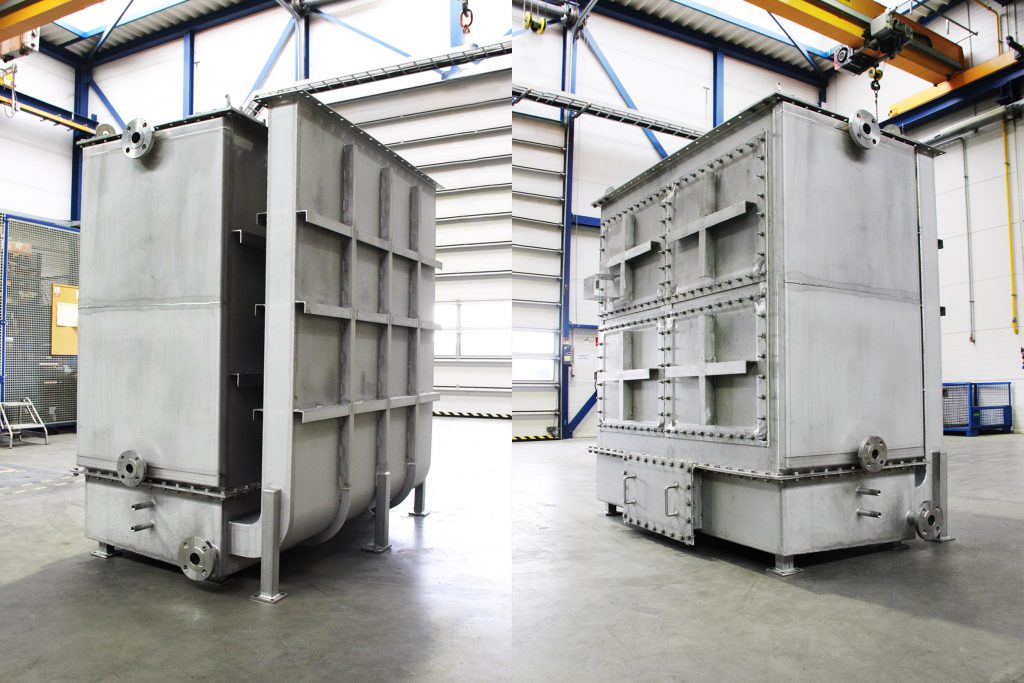Process
RECOVERY OF INDUSTRIAL WASTE ENERGY OPTIONS ARE ENDLESS
Industrial heat recovery is feasible to nearly all process installations. With intelligent industrial engineering, waste heat can be regenerated and put to use in another part of your production process. Aside from the reduction in fuel usage and costs, this is an important method to improve sustainability and reduce the greenhouse emission.
Waste heat turns to energy
Without a heat transfer system, waste heat generated, for example, during combustion or the production process is “dumped” into the environment. By installing a heat recovery application, the heat can be transferred into recycled energy offering production efficiency and both economical and environmental profits. Geurts engineers, builds and supplies a wide variety of heat exchanging and heat recovery equipment. We offer a total solution concept; from thermal engineering to mechanical engineering, project management, and in-house production for the following processes:

INDUSTRIAL COOLING
Heat exchangers are commonly used in various industries as cooling equipment to cool fluids. In many plants, fluids are cooled using heat exchangers for:
- air-to-liquid cooling
- liquid-to-air cooling
- liquid-to-liquid cooling
- or air-to-air cooling
Example application: Milk cooling water
By combining a compact shell and coil heat exchanger to a milking robot, the milk will be pre-cooled by the cattle drinking water before it flows into the milk cooling tank. As a result, the total cooling process offers a reduction in energy consumption, and subsequently, it will save on energy costs. Another typical usage of our coolers implemented in industrial processes:
- Cooling of flue gas
- Hot water cooling
- Ethylene glycol cooling
- Biogas treatment (Gas cooling drying process)
- Gas cooling
- Oil cooling
More information:
CONDENSING
Next to cooling, heat exchangers are just as commonly used as a cooling device in which vapors transfer into liquids by removing the latent heat utilizing a coolant such as water or another fluid. For example, with a condensing boiler, the latent heat from the exhaust gasses that would otherwise be discharged into the atmosphere through the flue, is vapored into liquid condensate. Much more than with a standard efficiency boiler, condensing boilers offer at least 90% efficiency, which means that they turn 90% of the fuel they use into heat. In many industrials plants, condensation of fluids is required to remove contaminations, pollutions, odour, or recovery of vaporous refrigerant gas to liquid.
Example application: biogas industry
Biogasses that are commonly used in combined heat and power (CHP) plants, need to be cleaned and upgraded to a certain standard applicable for combustion. This applies to gasses obtained from fermentation processes as well as landfill and sewage gas. Cooling the biogas produces a condensate free from contaminants. Reheating the condensate provides a form of biogas suitable for the CHP. More information:
INDUSTRIAL HEATING
Industrial boilers, kilns, ovens and furnaces generate hot flue gasses that are, to various extents, harmful for the environment. Geurts has developed innovative ways to recover this waste heat. Investing in one of the many varieties of heat exchangers improves production process efficiency and productivity, turns waste heat into cost cutbacks and reduces the environmental impact. In many industrial production installations liquids, gasses or even solids need to be heated or preheated. Heating and preheating water, thermal oil, glycol, crude oil, gas, air for combustion, biogas reheating, and steam production are commonly done by utilizing a heat exchanger.
Example application: natural gas industry
In many natural gas processing systems, the transport of gas under pressure is a key element. Taking into account that the Joule-Thomson effect (when reducing the pressure, also the gas temperature drops) creates operational and material quality problems in the distribution networks, preheating the natural gas before pressure reduction solves this issue. For this application, Geurts supplies heat exchangers using steam or hot water as a thermal carrier fluid.
Example application: odour reduction systems
Applying heat exchangers to the condensation process in the farming industry results in soluble pollutant to partly dissolve. In addition to recovering energy, an odour effect reduction of 30 – 85% can be attained. More information:
VAPORIZER OR EVAPORATOR
A vaporizer, or evaporator, is the generic term for equipment that converts liquids into a vapor, for the purpose of humidifying air (using liquid water) or converting a process fluid into a process vapor. Vaporizers are applicable for two basic purposes: to generate a vapor or to transfer heat. Similar to industrial boilers, vaporizers transfer heat into energy but at lower temperatures and pressures. To effect the evaporation, the vaporizer heat transfer device utilizes latent heat from a part of your production process, for instance, a boiler. Heat addition can be effected by a hot fluid or by combustion products. In some specific applications (such as a refrigeration cycle) the term evaporator is also used to describe the heat transfer equipment that evaporates the cold and liquid refrigerant by transferring heat from a hot process fluid.
Example application: ORC installation
Evaporators are commonly used in ORC installations at lower temperatures and pressures. The working fluid is heated up to the boiling point, evaporated and superheated. An ORC installation with evaporator regenerates flue gas heat and supplies a surplus of energy. More information:
High quality materials and standards
Optimal heat transfer or heat regeneration in the various processes means selecting the ultimate design and high-quality materials, depending on the type of fluid, quantity of fluid and application. At Geurts, we have supplied our customers over 20 years of various designs of heat exchanger types. We engineer our designs according to the codes:
- PED
- AD Merkblätter
- ASME (including U-stamp)
- TEMA
- Specific regulations of notified bodies DNV, GL, LR, ABS
We have many other solutions and examples to share with you. Please feel free to contact us for more information.

 Dutch
Dutch German
German French
French